Introduction
Lead scoring is an essential methodology in the realm of B2B sales and marketing. At its core, it involves assigning a numerical score to each lead, typically on a scale from 1 to 100, to gauge their likelihood of making a purchase.
This process is a strategic approach to understand the potential of every lead that comes into the sales funnel. It enables sales and marketing teams to prioritize leads, ensuring they focus their efforts on high scoring leads, which are those most likely to generate revenue.
Traditionally, lead scoring has been a manual process, relying on sales and marketing professionals’ intuition and experience to rank leads. However, with advancements in AI and workflow automation, manual tasks associated with lead scoring can be automated completely. We shall discuss all this is detail in our blog.
Lead Scoring Metrics
Modern lead scoring methodologies now incorporate a mix of explicit and implicit scoring metrics, and can also incorporate predictive scoring to build a framework which arrives at accurate lead scores for your leads.
- Explicit scoring involves using concrete information such as job title, company size, or industry.
- Implicit scoring is based on behavioral data like website visits, email engagement, or content downloads.
- Predictive scoring acts as a layer on traditional explicit and implicit methods. Predictive scoring can –
- use AI on the data around your existing customers and your accepted & rejected leads, to give a lead score.
- use LLMs to replace the subjective decision making tasks in the lead scoring workflow.
Lead Scoring Methods
Let us now discuss popular frameworks used for lead scoring in detail. You can implement any of these frameworks and integrate them into your CRM and other apps using the Nanonets Workflow Builder, which will be covered after this section.
Explicit Lead Scoring Methods
Explicit methods focus on tangible, solid data to evaluate the potential of leads. These methods are grounded in specific, often demographic, information about a lead.
1. BANT (Budget, Authority, Need, Timeframe)
Description:
BANT is a classic lead scoring method where leads are assessed based on four critical criteria: Budget, Authority, Need, and Timeframe.
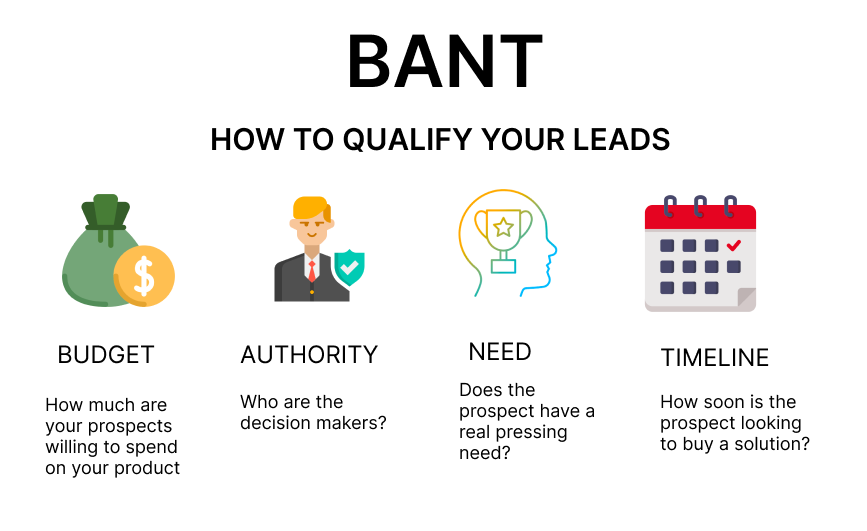
- Budget: Determines if the lead has the financial resources to buy.
- Authority: Assesses if the contact person can make purchasing decisions.
- Need: Identifies if the lead’s needs align with the product or service offered.
- Timeframe: Checks how soon the lead intends to make a purchase.
Workflow Example:
- A lead comes in through an online form.
- The form data is enriched using a tool like Clearbit to gather more detailed information about the lead’s company and role.
- In the CRM, a scoring rule is applied where points are assigned based on how well the lead matches each BANT criterion, based on pre-set rules on the enriched data.
- For instance, if the lead has a high authority level in their company and a pressing need for the product, they score higher.
- The CRM then updates the lead’s score, prioritizing them for the sales team.
2. Firmographic Scoring
Description:
This method scores leads based on firmographic data such as company size, sector, location, and revenue. It’s particularly useful in B2B scenarios where such factors significantly impact the likelihood of a sale.
Workflow Example:
- A lead is identified via LinkedIn.
- Company information is enriched using a tool like Clearbit to gather more detailed information about the lead’s company and role.
- The CRM scores the lead based on predefined firmographic criteria. For example, a large enterprise in a target sector may receive a higher score.
- This score helps in segmenting leads for tailored marketing strategies.
3. ANUM (Authority, Need, Urgency, Money)
Description:
ANUM is another variant that prioritizes the authority and need of a lead, along with urgency and budget considerations.
Workflow Example:
- A potential lead interacts with a webinar hosted by the company.
- Post-webinar, their engagement and queries are analyzed for urgency and need based on the interaction.
- Their role and company are checked for authority and budget, typically done manually or via a lead enrichment tool.
- The CRM then assigns scores based on these criteria, fast-tracking leads with immediate needs and high purchasing power.
Automate lead enrichment, qualification and scoring workflows with our AI-driven workflow builder, designed by Nanonets for you and your teams.
Implicit Lead Scoring Methods
Implicit lead scoring focuses on the prospective customer’s behavior and engagement to gauge their interest and potential to convert. These methods assess how leads interact with your brand, website, or content, offering insights that aren’t always apparent through explicit data.
1. Engagement Scoring
Description:
Engagement (or behavorial) scoring examines the actions leads take, like the type of content they consume, the duration of their website visits, and their responses to marketing campaigns.
Workflow Example:
- A lead regularly opens marketing emails and spends time on high-value pages like product demos or pricing.
- Each action (page visit, download, email opens) is tracked and points are assigned based on the level of engagement.
- The CRM, integrated with website analytics using workflow automation, updates the lead’s score automatically.
- High engagement leads are flagged for follow-up by the sales team.
2. Content Interaction Scoring
Description:
Leads are scored based on the type and depth of content they interact with, such as blog articles, whitepapers, or videos. More in-depth interactions with technical or advanced content may indicate a higher level of interest.
Workflow Example:
- A lead spends time reading advanced technical blogs and viewing tutorial videos.
- Content management systems track these interactions, assigning higher scores for deeper engagement with complex content.
- This information is integrated into the CRM, raising the lead’s score.
- Leads engaging with advanced content are flagged as high-potential leads for the sales team.
Predictive Lead Scoring Methods
Predictive methods use AI with traditional methods to automate or increase accuracy.
1. LLM based Lead Scoring (Used with Explicit Lead Scoring)
This approach uses LLMs to gauge subjective parameters in explicit scoring such as Budget, Authority, Need, Timeframe in the BANT framework. This removes the manual task where a salesperson needs to fill the BANT form for a lead based on their personal interaction and available company information.
2. Machine Learning-Based Scoring (Used with Implicit Lead Scoring)
This approach uses machine learning algorithms to analyze past lead data, identifying patterns and characteristics of leads that successfully converted. The system then scores new leads based on how closely they match these success profiles.
We shall learn how this works in detail in the next section with the help of an example.
Automate lead enrichment, qualification and scoring workflows with our AI-driven workflow builder, designed by Nanonets for you and your teams.
Automated Lead Scoring using Nanonets
Let’s take the example of a BANT workflow and automate it using Nanonets Workflows. The existing manual workflow looks like this –
- Lead enters a form and provides email and a convenient time for a sales call.
- Salesperson creates a new record in Hubspot CRM.
- Salesperson creates the call event in Google Calendar based on the specified time indicated by the lead.
- Once the call is over, the salesperson uses his subjective memory of the call discussion and the sales call transcript fetched from Gong to fill the BANT form with Budget, Authority, Need, Timeframe fields.
- The lead score is thus calculated by the sales person using the filled BANT form and a pre-set formula with weights to each field.
- The lead score is updated manually in the corresponding Hubspot CRM record.
Now let us take a look at how we can automate this using Nanonets by creating an automated workflow that does all the tasks of the above workflow for us.
We feed the description of the workflow we wrote above as a prompt in the workflow generator, and an automated workflow spins up for us based on our description.

We move on and authenticate our Google, Hubspot and Gong accounts to provide the Nanonets workflow with access to the apps in order to facilitate the workflow to fetch data and perform actions directly within your apps.
The workflow runs as follows –
- Google Forms – Triggers a workflow run when the sales call Google Form is submitted.
- Hubspot – New Hubspot record is created with the email submitted by the lead.
- Google Calendar – New calendar event is created between the lead and the salesperson based on the time indicated.
- Gong – The workflow is delayed till the call happens. Once the call is done, the sales call transcript is fetched from Gong
- Nanonets AI – Nanonets AI reads the transcript and populates the BANT fields in a structured fashion.
- Nanonets AI – Nanonets AI uses self selected (default) weights for arriving at a lead score, from the BANT data extracted from the call transcript in the previous step. You can specify the lead score formula and the weights manually in the prompt as well.
- Hubspot – The Hubspot record created in the second step is populated with this lead score.
Here is a demo of the workflow in action.
Let’s take a look at the results of automated lead scoring compared to manual lead scoring now.
Lead Scoring Case Study
Challenge: Sales teams often struggle with lead scoring, spending substantial time on manual processes that are prone to incomplete information and subjectivity. The BANT (Budget, Authority, Need, Timeline) framework, while effective, traditionally required time-consuming efforts and could result in biased lead scoring.
Solution: Created a Nanonets Workflow – integrating AI to transform the lead qualification process. This tool automates the extraction and analysis of BANT criteria from sales calls, offering a streamlined, efficient approach to lead scoring.
Workflow:

The workflow runs as follows –
- Google Forms – Triggers a workflow run when the sales call Google Form is submitted.
- Hubspot – New Hubspot record is created with the email submitted by the lead.
- Google Calendar – New calendar event is created between the lead and the salesperson based on the time indicated.
- Gong – The workflow is delayed till the call happens. Once the call is done, the sales call transcript is fetched from Gong
- Nanonets AI – Nanonets AI reads the transcript and populates the BANT fields in a structured fashion.
- Nanonets AI – Nanonets AI uses self selected (default) weights for arriving at a lead score, from the BANT data extracted from the call transcript in the previous step. You can specify the lead score formula and the weights manually in the prompt as well.
- Hubspot – The Hubspot record created in the second step is populated with this lead score.
Results & Impact:
- Enhanced Precision: In a study comparing over 1500 sales calls, the workflow matched or outperformed AEs in identifying leads likely to close. Notably, its recall rate was 81%, significantly higher than the manual review’s 41%, while the precision rate was similar.
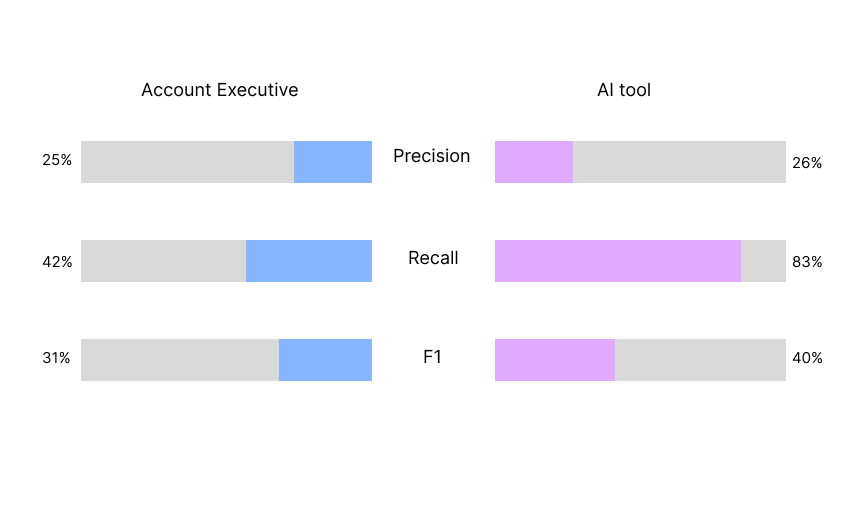
- Reduced Cycle Times: Leads scored 80+ by the AI tool showed 5-10% shorter closure cycle times, enhancing sales team efficiency.
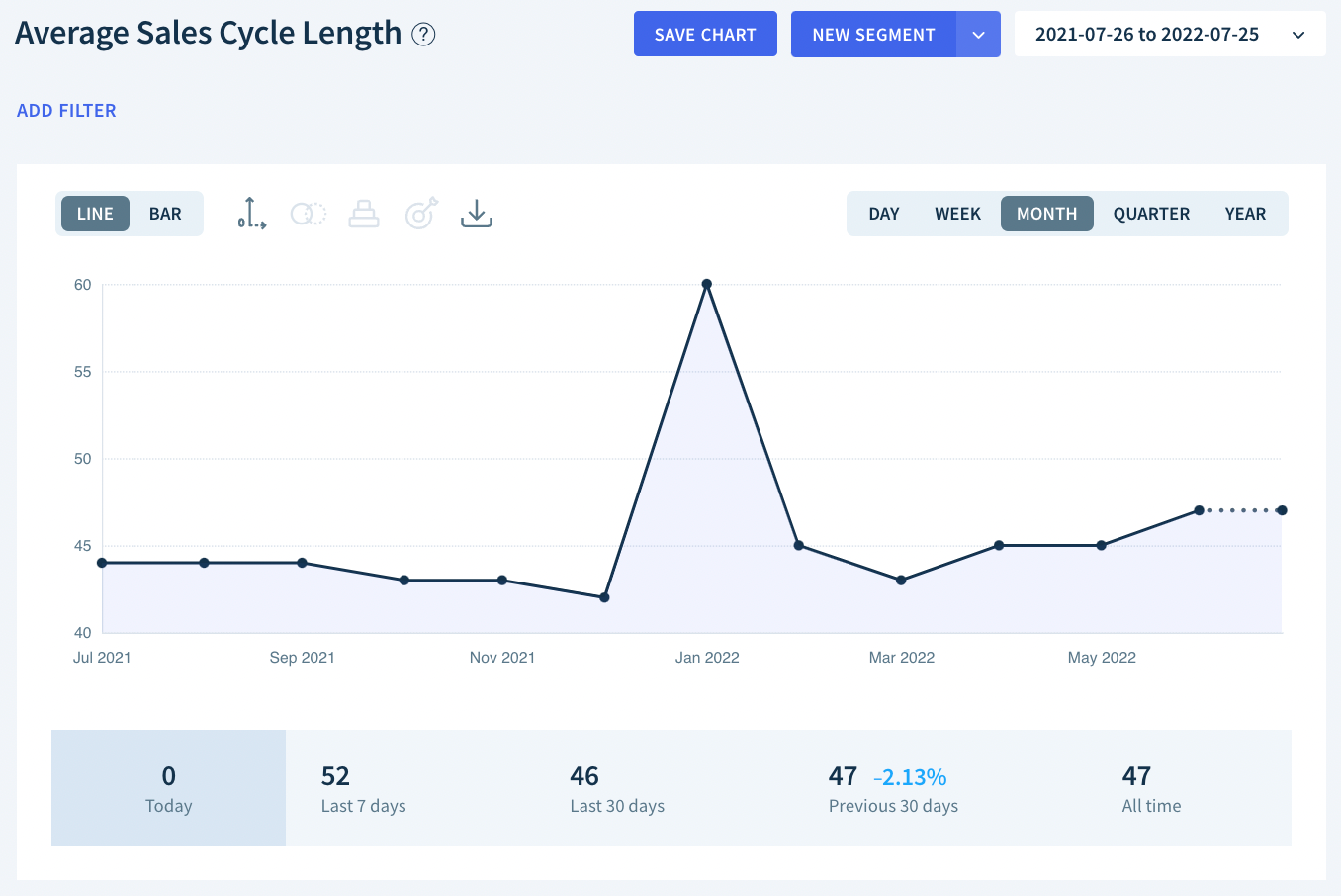
- Flexible Scoring: Unlike binary AE assessments, AI provides a nuanced 1-100 scoring scale, allowing more tailored sales approaches.
- Efficiency Gains: Sales teams reported faster BANT qualification, elimination of incomplete data issues, and more time for customer engagement and product development.
Conclusion: Workflow automation of lead scoring marked a significant leap in sales efficiency, combining human intuition with AI precision for more effective, customer-centric strategies.
Nanonets for Workflow Automation
In today’s fast-paced business environment, workflow automation stands out as a crucial innovation, offering a competitive edge to companies of all sizes. The integration of automated workflows into daily business operations is not just a trend; it’s a strategic necessity. In addition to this, the advent of LLMs has opened even more opportunities for automation of manual tasks and processes.
Welcome to Nanonets Workflow Automation, where AI-driven technology empowers you and your team to automate manual tasks and construct efficient workflows in minutes. Utilize natural language to effortlessly create and manage workflows that seamlessly integrate with all your documents, apps, and databases.
Our platform offers not only seamless app integrations for unified workflows but also the ability to build and utilize custom Large Language Models Apps for sophisticated text writing and response posting within your apps. All the while ensuring data security remains our top priority, with strict adherence to GDPR, SOC 2, and HIPAA compliance standards.
To better understand the practical applications of Nanonets workflow automation, let’s delve into some real-world examples.
- Automated Customer Support and Engagement Process
- Ticket Creation – Zendesk: The workflow is triggered when a customer submits a new support ticket in Zendesk, indicating they need assistance with a product or service.
- Ticket Update – Zendesk: After the ticket is created, an automated update is immediately logged in Zendesk to indicate that the ticket has been received and is being processed, providing the customer with a ticket number for reference.
- Information Retrieval – Nanonets Browsing: Concurrently, the Nanonets Browsing feature searches through all the knowledge base pages to find relevant information and possible solutions related to the customer’s issue.
- Customer History Access – HubSpot: Simultaneously, HubSpot is queried to retrieve the customer’s previous interaction records, purchase history, and any past tickets to provide context to the support team.
- Ticket Processing – Nanonets AI: With the relevant information and customer history at hand, Nanonets AI processes the ticket, categorizing the issue and suggesting potential solutions based on similar past cases.
- Notification – Slack: Finally, the responsible support team or individual is notified through Slack with a message containing the ticket details, customer history, and suggested solutions, prompting a swift and informed response.
- Automated Issue Resolution Process
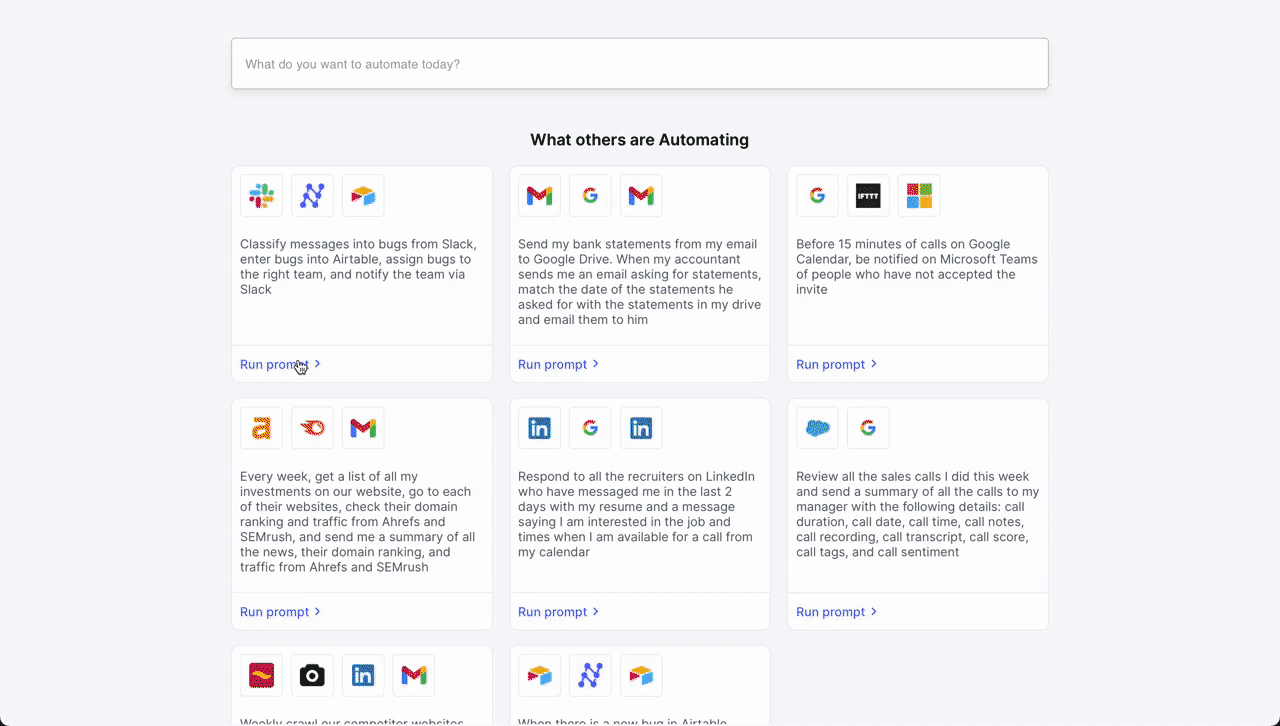
- Initial Trigger – Slack Message: The workflow begins when a customer service representative receives a new message in a dedicated channel on Slack, signaling a customer issue that needs to be addressed.
- Classification – Nanonets AI: Once the message is detected, Nanonets AI steps in to classify the message based on its content and past classification data (from Airtable records). Using LLMs, it classifies it as a bug along with determining urgency.
- Record Creation – Airtable: After classification, the workflow automatically creates a new record in Airtable, a cloud collaboration service. This record includes all relevant details from the customer’s message, such as customer ID, issue category, and urgency level.
- Team Assignment – Airtable: With the record created, the Airtable system then assigns a team to handle the issue. Based on the classification done by Nanonets AI, the system selects the most appropriate team – tech support, billing, customer success, etc. – to take over the issue.
- Notification – Slack: Finally, the assigned team is notified through Slack. An automated message is sent to the team’s channel, alerting them of the new issue, providing a direct link to the Airtable record, and prompting a timely response.
- Automated Meeting Scheduling Process
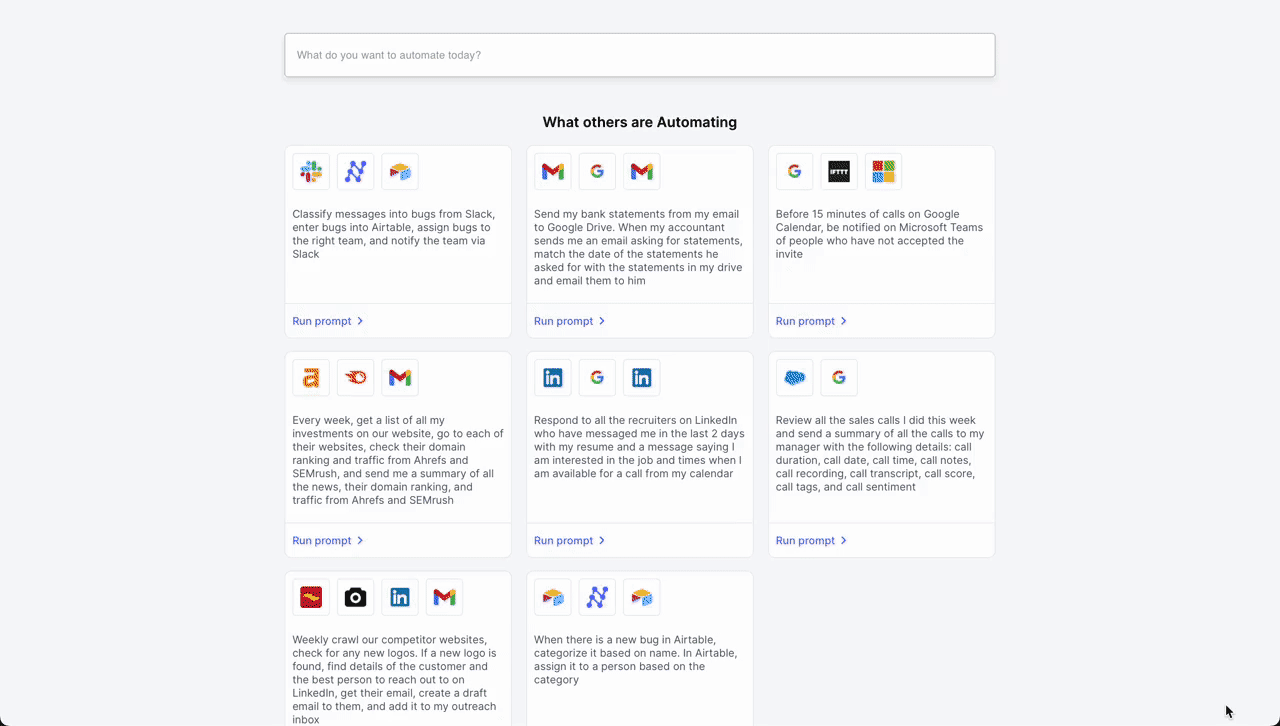
- Initial Contact – LinkedIn: The workflow is initiated when a professional connection sends a new message on LinkedIn expressing interest in scheduling a meeting. An LLM parses incoming messages and triggers the workflow if it deems the message as a request for a meeting from a potential job candidate.
- Document Retrieval – Google Drive: Following the initial contact, the workflow automation system retrieves a pre-prepared document from Google Drive that contains information about the meeting agenda, company overview, or any relevant briefing materials.
- Scheduling – Google Calendar: Next, the system interacts with Google Calendar to get available times for the meeting. It checks the calendar for open slots that align with business hours (based on the location parsed from LinkedIn profile) and previously set preferences for meetings.
- Confirmation Message as Reply – LinkedIn: Once a suitable time slot is found, the workflow automation system sends a message back through LinkedIn. This message includes the proposed time for the meeting, access to the document retrieved from Google Drive, and a request for confirmation or alternative suggestions.
- Invoice Processing in Accounts Payable
- Receipt of Invoice – Gmail: An invoice is received via email or uploaded to the system.
- Data Extraction – Nanonets OCR: The system automatically extracts relevant data (like vendor details, amounts, due dates).
- Data Verification – Quickbooks: The Nanonets workflow verifies the extracted data against purchase orders and receipts.
- Approval Routing – Slack: The invoice is routed to the appropriate manager for approval based on predefined thresholds and rules.
- Payment Processing – Brex: Once approved, the system schedules the payment according to the vendor’s terms and updates the finance records.
- Archiving – Quickbooks: The completed transaction is archived for future reference and audit trails.
- Internal Knowledge Base Assistance

- Initial Inquiry – Slack: A team member, Smith, inquires in the #chat-with-data Slack channel about customers experiencing issues with QuickBooks integration.
- Automated Data Aggregation – Nanonets Knowledge Base:
- Ticket Lookup – Zendesk: The Zendesk app in Slack automatically provides a summary of today’s tickets, indicating that there are issues with exporting invoice data to QuickBooks for some customers.
- Slack Search – Slack: Simultaneously, the Slack app notifies the channel that team members Patrick and Rachel are actively discussing the resolution of the QuickBooks export bug in another channel, with a fix scheduled to go live at 4 PM.
- Ticket Tracking – JIRA: The JIRA app updates the channel about a ticket created by Emily titled “QuickBooks export failing for QB Desktop integrations,” which helps track the status and resolution progress of the issue.
- Reference Documentation – Google Drive: The Drive app mentions the existence of a runbook for fixing bugs related to QuickBooks integrations, which can be referenced to understand the steps for troubleshooting and resolution.
- Ongoing Communication and Resolution Confirmation – Slack: As the conversation progresses, the Slack channel serves as a real-time forum for discussing updates, sharing findings from the runbook, and confirming the deployment of the bug fix. Team members use the channel to collaborate, share insights, and ask follow-up questions to ensure a comprehensive understanding of the issue and its resolution.
- Resolution Documentation and Knowledge Sharing: After the fix is implemented, team members update the internal documentation in Google Drive with new findings and any additional steps taken to resolve the issue. A summary of the incident, resolution, and any lessons learned are already shared in the Slack channel. Thus, the team’s internal knowledge base is automatically enhanced for future use.
The Future of Business Efficiency
Nanonets Workflows is a secure, multi-purpose workflow automation platform that automates your manual tasks and workflows. It offers an easy-to-use user interface, making it accessible for both individuals and organizations.
To get started, you can schedule a call with one of our AI experts, who can provide a personalized demo and trial of Nanonets Workflows tailored to your specific use case.
Once set up, you can use natural language to design and execute complex applications and workflows powered by LLMs, integrating seamlessly with your apps and data.

Supercharge your teams with Nanonets Workflows allowing them to focus on what truly matters.
Automate lead enrichment, qualification and scoring workflows with our AI-driven workflow builder, designed by Nanonets for you and your teams.

